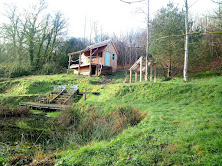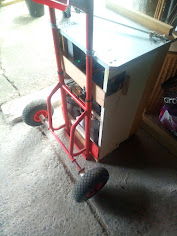Here are a few pictures of my recent projects.
| This is a typical freestanding wooden framework designed to support 3 solar panels. | In Remote location | The power pack unit fed by the panels was for a 12v lighting system |
There has certainly been a huge increase in demand for off grid systems in the UK over the last decade. If you are serious about getting an alternative power system, and you think solar is the way to go, then the first thing to consider is how much sun you get where you live? As sun is the main factor in a solar system, then this will be what should determine your first decision.
What I need to know about off grid before I decide?
If you decide to go with an off grid system, (whether it be to cover short periods when there are power cuts, or for longer periods when trying cut fuel bills) what you will need to do is to have some idea off what you need to power. First rule of thumb, be realistic. Unless you have money growing on trees in the garden, then you need to think essential items only. So when you got through the list of items you really believe are essential, the second thing you must do is check how much power (in watts) these items on your list are using. Now in some cases that information is found on a label stuck on the item. More often than not you will find that the information has faded, but all is not lost, because you can in fact use a watt meter. (paid link)
Why do I need a watt meter?
By adding the total amount of wattage used, you will be able to work out the amount of power they use. But as most items will not be running all the time, it will also be necessary to calculate how much time these items are running. Then you will have the total wattage per hour, which can then be calculated into amps per hour. This will only work with appliances and items that are plugged into a socket, lighting for example will in many cases not be a freestanding plug in light, so lighting has to be calculated by the wattage written on the bulb.
Please note, some items in your essential list can be powered by DC.
What is DC?
DC is direct current which comes from batteries and solar panels. Compared to AC.
What is AC?
AC is alternating current, which comes from the grid (supplied by your utility company) or from a generator.
So what items in my list could be DC?
Lighting in general, and maybe you could buy a 12v kettle, if you have a gas hob, and you are using an electric kettle it may be more economical to buy a kettle for the hob.
How do you determine how many batteries I will need?
Once you know which items are going to be DC powered, then everything else needs AC, but for a DC power source to convert from a lower voltage to a higher voltage you are going to need an inverter. This may sound like the question about ("How many batteries I need") is not being answered, well in fact it is.
The thing is it is possible to have a 12v 24v and 48v DC supply being inverted to 240v and to do that more batteries are needed as well as an inverter that is rated to the particular voltage you are going with.
Things to consider, an inverter rated at 12v has to jump further to reach 240v as opposed to a 24 or 48v battery bank.
The minimum amount of batteries one needs for 24v is 2 x 12v wired in series. For 48v 4 x 12v batteries are needed. Don't forget that in each case, the amperage will need to be considered for the maximum amps required per hour.
Batteries can be rated 30ah and still be 12v, but they will drain in no time at all. So here we must go back to our wattage calculation, convert that to amp hours (Ah). Once you have the amp hours worked out, you can find batteries with an Ah rating that will power your devices and appliances via an inverter.
My first project
The most useful thing I was able to put together was a power supply on wheels.
| |
|
|
It does look a little rough around the edges I admit, but when the power goes down for the weekend, or you have a bit of land with no power supply that needs strimming (without using that expensive fuel) then this is what you need to consider.
The basics are that it uses 2 x 12v batteries in parallel which produces 12v 2400wh. Next, there is the pure sine inverter (middle bottom) (paid link) to enable the use of 240v (UK) items. (not a washing machine of tumble dry admittedly but certainly a fridge or fridge freezer. The other options include a 12v fuse holder (bottom right) (paid link) and a car cigarette lighter socket connection for things like tyre pumps. Tyres, as in wheelbarrows or even the tyres on the cart itself.
There is an MPPT Charge controller (paid link)to regulate the amount necessary to charge the batteries and an item to help set the MPPT Charge controller up call an MT50 (top right)(paid link) .
I used Renogy lithium batteries that cost a ridiculous amount of money, but the benefit of them being much lighter than other kind of batteries made it possible to move around. I believe Renogy, have now made the same battery but with a self heating element.
Re: the sack trolley. It has to carry quite a weight as the container itself (made of wood) weighs a lot.
Also bear in mind the wheel axle width from wheel to wheel. The wider that is, the better it will travel over rugged terrain. I modified, the one I bought. Don't forget that pneumatic (paid link) tyres make life easier as well.
This link here (paid link) will take you to what looks just the job.

.jpg)






